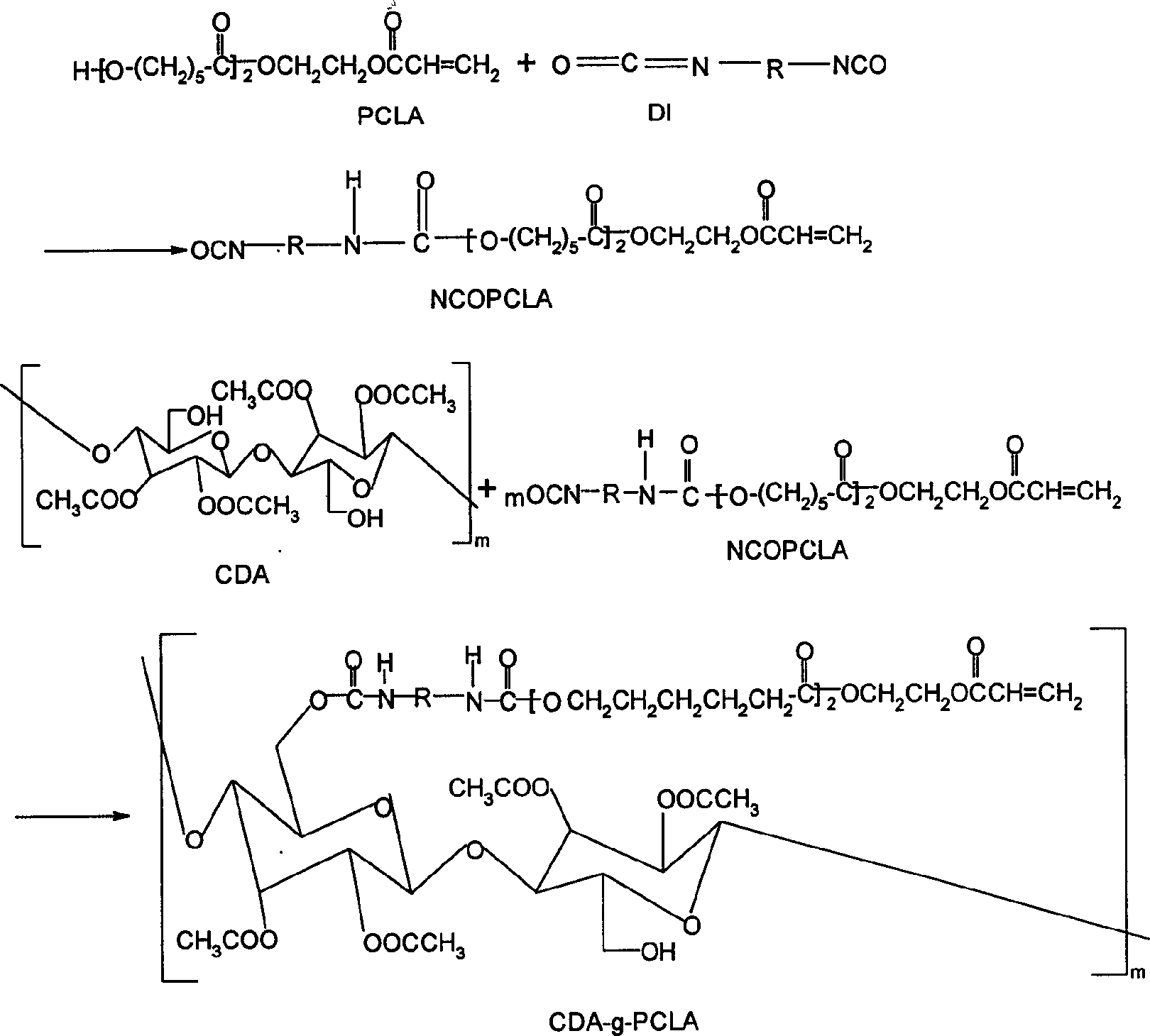Cellulose derivative grafted copolymer and its synthesis method
A technology of cellulose derivatives and graft copolymers, applied in the field of cellulose derivatives graft copolymers and their synthesis, can solve the problems of high flow temperature and limited processing performance.
- Summary
- Abstract
- Description
- Claims
- Application Information
AI Technical Summary
Problems solved by technology
Method used
Image
Examples
Embodiment 1
[0028] 3.44 grams of polycaprolactone monoacrylate with a molecular weight of 344 were dissolved in 17 milliliters of acetone, and 1.74 grams of 2,4-toluene diisocyanate was added. After reacting for 2.5 hours under reflux conditions, the terminal isocyanate was obtained by precipitation in petroleum ether. things. 17.22 grams of cellulose diacetate with a number-average molecular weight of 60,000 were dissolved in 180 milliliters of acetone, and the isocyanate-terminated prepolymer was added, and reacted for 8 hours under reflux conditions. After the acetone was volatilized and extracted for 24 hours, 22.00 grams of CDA was obtained. - g-PCLA graft copolymer. Grafting rate is 27.76%, W PCLA was 13.82%. The apparent flow temperature of CDA-g-PCLA is 208-210°C, which is about 37°C lower than the apparent flow temperature of cellulose diacetate (245-250°C). The viscous flow temperature of CDA-g-PCLA is 209.40℃, which is 36.05℃ lower than that of cellulose diacetate (245.45℃)....
Embodiment 2
[0030] 5.72 grams of polycaprolactone monoacrylate with a molecular weight of 572 were dissolved in 29 milliliters of acetone, and 2.50 grams of 4,4'-diphenylmethane diisocyanate was added. After reacting for 3 hours under reflux conditions, the isocyanate-terminated preprecipitated product was obtained by precipitation in petroleum ether. Polymer. 12.30 grams of cellulose diacetate with a number-average molecular weight of 78,000 were dissolved in 130 milliliters of acetone, and an isocyanate-terminated prepolymer was added, and reacted for 10 hours under reflux conditions. After volatilization and removal of acetone, 19.10 grams of CDA were obtained after extraction with toluene for 24 hours. - g-PCLA graft copolymer. The grafting rate is 55.28%, W PCLA was 22.51%. The apparent flow temperature of CDA-g-PCLA is 210-212°C, which is about 37°C lower than the apparent flow temperature of cellulose diacetate (247-249°C). The viscous flow temperature of CDA-g-PCLA is 209.47°C,...
Embodiment 3
[0032] 5.14 grams of polycaprolactone monoacrylate with a molecular weight of 1028 were dissolved in 26 milliliters of acetone, and 0.93 grams of 1,6-hexamethylene diisocyanate was added. After reacting for 4 hours under reflux conditions, the terminal isocyanate was obtained by precipitation in petroleum ether. Polymer. 7.38 grams of cellulose acetate with a number-average molecular weight of 94,000 were dissolved in 75 milliliters of acetone, added with an isocyanate-terminated prepolymer, and reacted for 11 hours under reflux conditions. After removing the acetone by volatilization, 12.03 grams of CDA- g-PCLA graft copolymer. Grafting rate is 63.01%, W PCLA was 30.92%. The apparent flow temperature of CDA-g-PCLA is 196-198°C, which is about 52°C lower than the apparent flow temperature of cellulose diacetate (248-250°C). The viscous flow temperature of CDA-g-PCLA is 193.70℃, which is 51.75℃ lower than the viscous flow temperature of cellulose diacetate (245.45℃). The we...
PUM
| Property | Measurement | Unit |
|---|---|---|
| degree of grafting | aaaaa | aaaaa |
| degree of grafting | aaaaa | aaaaa |
| degree of grafting | aaaaa | aaaaa |
Abstract
Description
Claims
Application Information
 Login to View More
Login to View More - R&D
- Intellectual Property
- Life Sciences
- Materials
- Tech Scout
- Unparalleled Data Quality
- Higher Quality Content
- 60% Fewer Hallucinations
Browse by: Latest US Patents, China's latest patents, Technical Efficacy Thesaurus, Application Domain, Technology Topic, Popular Technical Reports.
© 2025 PatSnap. All rights reserved.Legal|Privacy policy|Modern Slavery Act Transparency Statement|Sitemap|About US| Contact US: help@patsnap.com

